The Mouse Inhalation Model of Cryptococcus neoformans Infection Recapitulates Strain Virulence in Humans and Shows that Closely Related Strains Can Possess Differential Virulence
- PMID: 30833336
- PMCID: PMC6479045
- DOI: 10.1128/IAI.00046-19
The Mouse Inhalation Model of Cryptococcus neoformans Infection Recapitulates Strain Virulence in Humans and Shows that Closely Related Strains Can Possess Differential Virulence
Abstract
Cryptococcal meningitis (CM) causes high rates of HIV-related mortality, yet the Cryptococcus factors influencing patient outcome are not well understood. Pathogen-specific traits, such as the strain genotype and degree of antigen shedding, are associated with the clinical outcome, but the underlying biology remains elusive. In this study, we examined factors determining disease outcome in HIV-infected cryptococcal meningitis patients infected with Cryptococcus neoformans strains with the same multilocus sequence type (MLST). Both patient mortality and survival were observed during infections with the same sequence type. Disease outcome was not associated with the patient CD4 count. Patient mortality was associated with higher cryptococcal antigen levels, the cerebrospinal fluid (CSF) fungal burden by quantitative culture, and low CSF fungal clearance. The virulence of a subset of clinical strains with the same sequence type was analyzed using a mouse inhalation model of cryptococcosis. We showed a strong association between human and mouse mortality rates, demonstrating that the mouse inhalation model recapitulates human infection. Similar to human infection, the ability to multiply in vivo, demonstrated by a high fungal burden in lung and brain tissues, was associated with mouse mortality. Mouse survival time was not associated with single C. neoformans virulence factors in vitro or in vivo; rather, a trend in survival time correlated with a suite of traits. These observations show that MLST-derived genotype similarities between C. neoformans strains do not necessarily translate into similar virulence either in the mouse model or in human patients. In addition, our results show that in vitro assays do not fully reproduce in vivo conditions that influence C. neoformans virulence.
Keywords: Cryptococcus; Cryptococcus neoformans; cryptococcosis; human; meningitis; model; mouse; pathogenesis; sequence type; virulence.
Copyright © 2019 American Society for Microbiology.
Figures
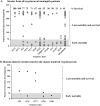
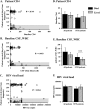

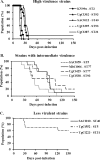
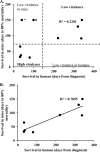
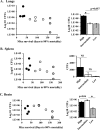
Similar articles
-
Identification of Pathogen Genomic Differences That Impact Human Immune Response and Disease during Cryptococcus neoformans Infection.mBio. 2019 Jul 16;10(4):e01440-19. doi: 10.1128/mBio.01440-19. mBio. 2019. PMID: 31311883 Free PMC article.
-
Cryptococcal genotype influences immunologic response and human clinical outcome after meningitis.mBio. 2012 Sep 25;3(5):e00196-12. doi: 10.1128/mBio.00196-12. Print 2012. mBio. 2012. PMID: 23015735 Free PMC article.
-
Cryptococcus neoformans ex vivo capsule size is associated with intracranial pressure and host immune response in HIV-associated cryptococcal meningitis.J Infect Dis. 2014 Jan 1;209(1):74-82. doi: 10.1093/infdis/jit435. Epub 2013 Aug 14. J Infect Dis. 2014. PMID: 23945372 Free PMC article.
-
Landmark clinical observations and immunopathogenesis pathways linked to HIV and Cryptococcus fatal central nervous system co-infection.Mycoses. 2020 Aug;63(8):840-853. doi: 10.1111/myc.13122. Epub 2020 Jun 19. Mycoses. 2020. PMID: 32472727 Free PMC article. Review.
-
Resistance and Tolerance to Cryptococcal Infection: An Intricate Balance That Controls the Development of Disease.Front Immunol. 2019 Jan 29;10:66. doi: 10.3389/fimmu.2019.00066. eCollection 2019. Front Immunol. 2019. PMID: 30761136 Free PMC article. Review.
Cited by
-
A dissemination-prone morphotype enhances extrapulmonary organ entry by Cryptococcus neoformans.Cell Host Microbe. 2022 Oct 12;30(10):1382-1400.e8. doi: 10.1016/j.chom.2022.08.017. Epub 2022 Sep 12. Cell Host Microbe. 2022. PMID: 36099922 Free PMC article.
-
Cryptococcus neoformans Genotypic Diversity and Disease Outcome among HIV Patients in Africa.J Fungi (Basel). 2022 Jul 15;8(7):734. doi: 10.3390/jof8070734. J Fungi (Basel). 2022. PMID: 35887489 Free PMC article. Review.
-
Resolving the Temporal Splenic Proteome during Fungal Infection for Discovery of Putative Dual Perspective Biomarker Signatures.J Am Soc Mass Spectrom. 2023 Sep 6;34(9):1928-1940. doi: 10.1021/jasms.3c00114. Epub 2023 May 24. J Am Soc Mass Spectrom. 2023. PMID: 37222660 Free PMC article.
-
Distinct pathways of adaptive evolution in Cryptococcus neoformans reveal a mutation in adenylyl cyclase with trade-offs for pathogenicity.Curr Biol. 2023 Oct 9;33(19):4136-4149.e9. doi: 10.1016/j.cub.2023.08.054. Epub 2023 Sep 13. Curr Biol. 2023. PMID: 37708888 Free PMC article.
-
The interplay of phenotype and genotype in Cryptococcus neoformans disease.Biosci Rep. 2020 Oct 30;40(10):BSR20190337. doi: 10.1042/BSR20190337. Biosci Rep. 2020. PMID: 33021310 Free PMC article. Review.
References
-
- Bicanic T, Meintjes G, Wood R, Hayes M, Rebe K, Bekker LG, Harrison T. 2007. Fungal burden, early fungicidal activity, and outcome in cryptococcal meningitis in antiretroviral-naive or antiretroviral-experienced patients treated with amphotericin B or fluconazole. Clin Infect Dis 45:76–80. doi:10.1086/518607. - DOI - PubMed
-
- Wiesner DL, Moskalenko O, Corcoran JM, McDonald T, Rolfes MA, Meya DB, Kajumbula H, Kambugu A, Bohjanen PR, Knight JF, Boulware DR, Nielsen K. 2012. Cryptococcal genotype influences immunologic response and human clinical outcome after meningitis. mBio 3:e00196-12. doi:10.1128/mBio.00196-12. - DOI - PMC - PubMed
Publication types
MeSH terms
Grants and funding
LinkOut - more resources
Full Text Sources
Other Literature Sources
Medical
Research Materials

